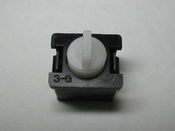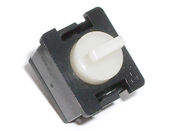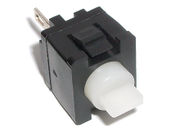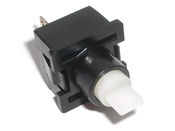Tokai MM9 series
This article is a stub: still need operation details. You can help Deskthority by expanding it.
| This article requires additional photographic illustration — clearer internals photos |
 | |
| Manufacturer | Tokai |
|---|---|
| Product code | MM9-1, MM9-2, MM9-3, MM9-4 |
| Switch type | Progressive rate |
| Sense method | Metal ball |
| Rated lifetime | 2M |
| Bounce time |
5 ms make, 10 ms break (MM9-1/2) 10 ms (MM9-3/4) |
| Peak force | 100±30 g |
| Total travel | 2.5±0.3 mm |
| Website | www.tokaicom.co.jp/original/swich/switch01.html |
Tokai MM9-series is a novel switch design that uses an alloy metal ball as part of the contact mechanism.
Contents
Description
The conductive ball is located inside a cage in the slider under tension from the main spring from above. When the switch is not pressed, the ball is held up partially by a prong in the slider and partially by a V-shaped groove in the first terminal. When the switch gets pressed, the slider's support of the ball drops and the ball gets pressed towards two prongs of the second terminal. When the ball touches both terminals, the switch is closed.[1]
The switches were described by the Tokai website as 「接点が回転するボールコンタクトスイッチ!」. "Ball contact switch with rotating contacts". The implication of is not clear; it could be suggesting that the ball rotation spreads out the contact wear, but it may simply be a very brief explanation of the operation. The switches have a comparatively short lifetime of only two million cycles; there are no flexible parts in the contact mechanism, which may be related. The website also classified the switches as 「メカニカルスイッチ」, "mechanical switch".
Switch travel is 2.5±0.3 mm. 「作動力」, "actuating force", is given as 100±30 g. This is not the actuation force but rather the peak/terminal force. The switch is progressive rate; the perceived action is progressive rate with knee, but in reality there is an instantaneous jump of around 25 cN at the actuation point, from around 45 cN to nearly 70 cN.[2] Actuation occurs at this point, followed by a stiff overtravel region up to the stated 100 g mark.
Variants
| Model | Switch mount | Keystem height | |
|---|---|---|---|
 |
MM9-1 | Plate mount with solder terminals | 6 mm |
 |
MM9-2 | Plate mount with solder terminals | 4 mm |
 |
MM9-3 | JIS C 2809 panel mount | 4 mm |
 |
MM9-4 | JIS C 2809 panel mount | 6 mm |
Keyboards
Clones
Kwanda manufacture clones of this switch series, as Kwanda PB11E01 and PB11E02. These and other clones do not correctly replicate the smooth and precise feel of MM9 however.
European patent 2667393A1 (and related patents) from 2013 depicts a switch similar to MM9-3 that does not use a metal ball. This switch is not a clone, as the terminal arrangement (directly side-by-side terminals) are of a separate type used by Sanwa and Hori but not Tokai. As with Sanwa SW-68, the unsealed shell has combined shell/plate retention clips. Figure 9A of the patent depicts a stepped progressive rate force curve similar to MM9 series, achieved as with the other designs by a pair of concentric springs; non-stepped progressive rate and near-linear curves are also catered for using different spring arrangements.
Gallery
MM9-1
Specifications
- MM9-1 and 2 dimensions (2008)
- MM9-3 dimensions (2008)
- MM9-4 dimensions (2008)
References
- ↑ Youtube—Tokai MM9 Switch Assembly and in Action. Posted by Yellow-SomethingIDGAF on 2018-10-24
- ↑ plotly — Tokai MM9-3 | scatter chart made by Haata
- ↑ MouseFan — TKC MM9-1スイッチ (Japanese) Retrieved 2015-08-02.
- ↑ Deskthority — First ever keyboard with Tokai MM9 switches discovered



